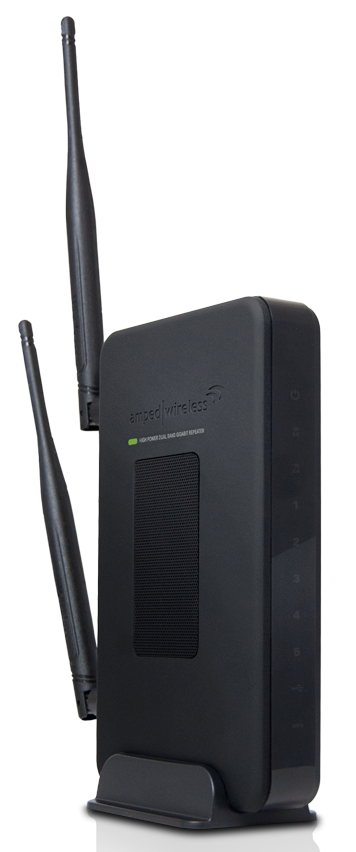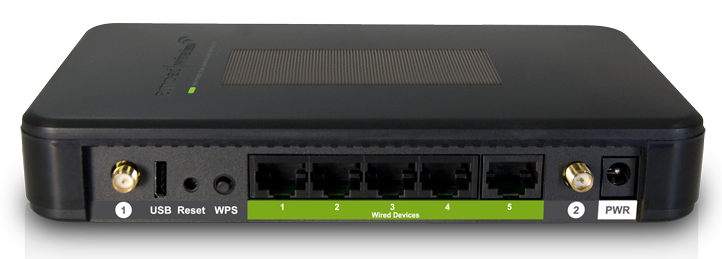Hands-on: Amped Wireless-N 600mW Dual Band Repeater
We look at a dual band wireless repeater that promises 2.4 GHz coverage of up to 10,000 square feet.
A few weeks ago, I did a hands-on with ZyXEL's Wireless N300 Range Extender (WRE2205), a wireless network extender that plugs directly into an electrical outlet.
Now I'm returning to wireless networking again with the Wireless-N 600mW Gigabit Dual Band Repeater (SR20000G) from Amped Wireless. This is a whole different beast but with the same goal: to extend your present wireless network out into the dead spots where the local router's coverage just can't reach. However this device has a larger pricetag, but it's payload is a lot bigger in return, offering support for both 2.4 GHz and 5.0 GHz bands and the ability to share a USB 2.0-stick or external hard drive across the network.
Instead of just extending the wireless network in a small area like the ZyXEL plug-in gadget, the Amped Dual Band Repeater actually takes the signal from a dual-band router, amplifies it, and pumps it out up to 10,000 square feet. Just imagine someone saying "duck" and then a second person repeats it for a third. Now imagine that second person using a bullhorn, letting more than just that third person hear the word "duck" in the near vicinity. That's seemingly what's going on with this repeater.
According to the spec sheet, the SR20000G is equipped with advanced dual 2.4 GHz 600mW amplifiers, 5.0 GHz amplifiers (roughly 500mW), two Reverse SMA connectors, and two external 5dBi dual band high gain antennas to extend Wi-Fi coverage. Like the ZyXEL gadget, there's no physical connection involved when setting up a link to the network's router – all you need is the same security key that's used on your wireless devices.
While I'm not going to go into detail about how my house is laid out as I did with the ZyXEL extender article, let's just say that my home is rather big, so big in fact that my network router – which is a top-of-the-line dual-band solution from a competitor – just can't reach to the other end of the house, try as it may. The little ZyXEL extender helped, but there were still dead spots, and at times the Netflix leechers loaded it down to the point where accessing the router directly, despite having a low throughput, was better.
With the SR20000G, there are no dead spots, even on the 5.0 GHz band which typically has issues with walls and other thick objects. Currently this extender sits roughly fifty feet away – the router is in my home office and the extender is in the den, separated by a closed in patio. Sitting out here next to the router, I can get a -53 dBm reading from the extender (100-percent signal) and -17 dBm from the router. Standing by the extender, I get a reading of -17 dBm and a reading of -62 dBm from the router. Remember, the closer to zero, the better.
So let's get crazy. My house resides on a corner, so out of curiosity, I walked out across the yard and stood next to the stop sign. I can't be sure of the distance -- maybe roughly 90 feet from the front door -- but I picked up a good number of Wi-Fi networks (and some odd stares since I was out in the night in my Atari pajamas). The Amped repeater measured -75 dBm at 70-percent strength, and the router measured -78 dBm at 64-percent signal strength – the router is somewhat closer to the street corner, yet the Amped repeater still provided a better signal. In the back yard, I got a -53 dBm from Amped and -60 dBm from the router. In the bathroom that resides on the other end of the house, the repeater pumped out -49 dBm at 100-percent and the router served up -69 dBm at 82-percent.
Get Tom's Hardware's best news and in-depth reviews, straight to your inbox.
All these measurements were taken by the Wi-Fi Analytics Android app provided by Amped Wireless, and using my Nexus 7 tablet which was connected to the repeater on the 2.4 GHz band the whole time. This app also provides additional charts like channel interference, a channel graph, a signal graph, and a signal meter. Initially all this information was used to determine where to put the SR20000G, and what channel both devices needed to be on in order to get the best signal. The app is free, and available on Google Play.
Just for kicks and to use a different means of measurement, WiFi Manager Premium showed the Nexus 7's connection to the router at 65 Mbps and 52 Mbps when connected to the Amped repeater – both numbers were recorded when sitting next to the router. Outside on the street corner and again standing next to the stop sign, both fluctuated from 19 Mbps to 5 Mbps, but the difference was that the SR20000G provided a more reliable connection (less fluctuation and connection dropouts)
Obviously there will be instances where one connection is better than the other, so it's ideal for end-users to install an app like WiFi Manager Premium that allows users to switch between devices by simply tapping a widget – I have one widget for each device, making it easy to switch to the router's connection when I'm in the office, and to the repeater when I'm inside the main house.
Found within this is a 620 MHz processor for handling all the Netflix leechers in the house. Both bands crank out 300 Mbps Rx and 300 Mbps Tx, but don't expect 10,000 square feet coverage on the 5.0 GHz band. As shown above, the device itself provides 5x Gigabit Ethernet ports and 1x USB 2.0 port, the latter of which can be used for sharing a USB stick or an external drive across the network as a local drive in Windows 7.
The initial setup was extremely easy, allowing me to connect my laptop via the Ethernet port and load up the SR20000G's Web-based interface. A setup guide quickly scanned the area and allowed me to choose the desired network router, enter the security key, and provide options for changing the default SSIDs on both extended networks, and to set up the repeater's own security key.
Once completed, users are greeted with a Web-based interface which is broken down into five categories: 5.0 GHz Wi-Fi Settings, 2.4 GHz Wi-Fi Settings, USB Storage, Network Settings and Management. The two network categories contain several sub-categories including Security, User Access, Access Schedule, and more. Everything you'd expect from a high-quality router is also present here in this repeater, including guest access, wireless coverage control, wireless access scheduling, MAC address filtering and more. What's missing are parental controls to block specific content without having to lock out an entire device or user.
According to the manual, the Dual Band Repeater automatically designates the Internet route for all devices connected through the Ethernet ports. That means wired desktops, laptops and other electronics can access either the 2.4 GHz or 5.0 GHz network. The repeater will automatically select the best active route, but there is an option to manually choose which network these wired devices should use.
Consumers looking to fill the dead spots in the home or office could benefit from the SR20000G, as it can extend 2.4 GHz and 5.0 GHz coverage. That means Internet connectivity in the back yard, while sitting in the car parked in the driveway, and even while sitting up in the attic hiding from the wife and kids.
For more information about the SR20000G, head here.

Kevin Parrish has over a decade of experience as a writer, editor, and product tester. His work focused on computer hardware, networking equipment, smartphones, tablets, gaming consoles, and other internet-connected devices. His work has appeared in Tom's Hardware, Tom's Guide, Maximum PC, Digital Trends, Android Authority, How-To Geek, Lifewire, and others.
-
Hupiscratch 10000 feet is approximately 929 m², for those who live in metric decimal system countries.Reply -
ipwn3r456 For anyone is getting that router, make sure to put a password or everyone around you is goona use your internet within 10000 feet...Reply -
eshlil Just change the SSID to FBI Surveillance Van, that will really mess with the neighbors.Reply -
_Cubase_ Impressive coverage... great if you live a couple of hundred metres from your local park and enjoy doing some work sitting on a park bench in the sun! But, yes: good security is a must, and a long-ass ASCII password!Reply -
fb39ca4 You don't want to be sitting right next to that thing when using it for long periods of time.Reply


